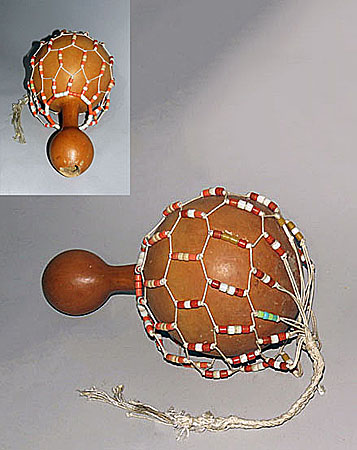
Owner: HWMC
Catalog#: 2AF-IDST-45
Rattles
Krio People 'Shaburay' Beaded Rattle
West Africa
Krio People of Sierra Leone
Calabash, beads, string
Field collected 1980s
Length: 15 inches
Idiophone – Struck Indirectly – Shaken -Rattle
A ‘shaburay’ (“sheqbureh”) of the Krio people of Sierra Leone. The netted gourd rattle is found throughout West and Central Africa with various names, such as jabara (Mali) and axatse (Ewe people of Ghana and Togo). In Nigeria it is predominantly called shekere.
This rhythmic rattle originated from Africa to accompany singing and dance, but is now used in Afro-Caribbean, Jazz, Salsa, and other popular music. The resonating body is made by drying the gourd for several months then removing the pulp and seeds. A beaded skirt (net) is added on the outside. A distinctive characteristic of the Krio ‘shaburay’ is the very loose net and long tail. Also, these colorful shaped beads are found in their clothing and decoration of women shoes. This instrument is given great respect and plays a very important role in traditional music. In Nigeria it is considered highly personal and is usually never loaned or shared.
The Sierra Leone Creole people (Krio: Krio pipul) are an ethnic group of Sierra Leone, who are descendants of freed African-Americans, Afro-Caribbean, and Liberated African slaves who settled in the Western Area of Sierra Leone between 1787 and about 1885. The colony was established by the British, supported by abolitionists, under the Sierra Leone Company as a place for freedmen. The settlers called their new settlement Freetown. Today, the Sierra Leone Creoles are 1.2 percent of the population of Sierra Leone.
Resource: https://en.wikipedia.org/wiki/Sierra_Leone_Creole_people
